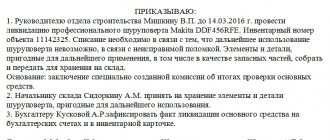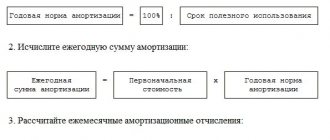Free receipt of OS in 1C: Accounting department of a state institution 8th edition 2.0
Published 06/24/2017 00:08 Fixed assets can be supplied to an institution not only through acquisition for a fee, but also free of charge. In this article, we will consider the reflection of the gratuitous receipt of OS in the program “1C: Public Institution Accounting 8, edition 2.0”.
Receipt of fixed assets free of charge can be divided into three types: 1. free receipt from an institution subordinate to the same GRBS (intradepartmental transfer); 2. receipt of fixed assets from the founder; 3. receipts of fixed assets from other budgets (from institutions subordinate to other GRBS). Let's consider all situations sequentially. Reflection of gratuitous receipt of fixed assets in accounting is carried out using the document “Acceptance for accounting of fixed assets, intangible assets, legal acts”. You can find it:
A list of documents opens:
Click the “Create” button to add a new document:
A special window opens with a list of types of receipt of fixed assets:
Type of receipt from account 106 is used in the case when the value of the fixed asset was previously accumulated in this account as a capital investment. The type of receipt to accounts 101,102,103 is used if a finished fixed asset is received. Other types of income are on off-balance sheet accounts for simplified accounting and storage. In our case, you need to select the “Receipt to account 101,102,103” type:
The document details are filled out in the standard way. But I would like to focus attention specifically on the “Financial Security Code” detail: according to which KFO should a fixed asset received free of charge be accepted for accounting? State-owned institutions use KFO 1 - “Activities carried out at the expense of the corresponding budget.” And for autonomous and budgetary institutions, KFO options are possible - 2 “Income-generating activities (institution’s own income)”, 4 “Subsidies for the implementation of state (municipal) tasks” or 7 “Funds for compulsory health insurance”. In general, we can say that two factors play a role in the choice of CFO: - with what means the accepted fixed asset will be maintained (that is, if you accept a fixed asset free of charge, for example, vehicles, then you need to consider from what means the maintenance will be carried out this vehicle); - and the second point concerns gratuitous transfer within the budget (among institutions subordinate to one GRBS): here it is worth considering which KFO the fixed asset is disposed of, usually in this case the OS is accepted for the same KFO. This is due to the fact that the “economy” of one GRBS during a gratuitous transfer among subordinate institutions should not change (that is, the total amount of fixed assets at each of the KFOs does not change, the transfer must be under the same KFO). Next, on the “Fixed assets, intangible assets, legal acts” tab, fill in the initial data of the fixed asset accepted for accounting:
If the fixed asset is transferred with depreciation, the depreciation data is indicated on this tab. After the basic information on the fixed asset is filled in, go to the “Accounting transaction” tab:
The data on the fixed asset do not differ for all three types of gratuitous receipt. The differences only appear in the typical accounting transaction that will be used.
1. Free receipt from an institution subordinate to the same GRBS (intradepartmental transfer) In the case of gratuitous receipt of a fixed asset in the order of intradepartmental transfer from another institution, the following standard operation is used:
In this standard transaction, the corresponding account will be account 304.04. After posting, the document generates the following account movements:
2. Receipt of fixed assets from the founder It can be from the founder (centralized receipt) and from institutions subordinate to the same GRBS. In the case of gratuitous receipt of fixed assets from the founder, the following standard operation is used:
In this typical transaction, the corresponding account will be account 401.10. After posting, the document generates the following account movements:
3. Receipts of fixed assets from other budgets (from institutions subordinate to other GRBS) When receiving property from other budgets, the following operation is used:
In this standard transaction, the corresponding account will also be account 401.10. The difference from the previous operation is KEK: in the previous operation it is KOSGU 180 “Other income”, in this one it is KOSGU group 150 “Receipts from...”:
The document generates the following transactions:
Author of the article: Svetlana Batomunkueva
Did you like the article? Subscribe to the newsletter for new materials
Add a comment
Comments
0 Nailya 08/26/2019 18:46 Good afternoon, please tell me that under the donation agreement they give video recorders and a surveillance camera monitor. How to capitalize in 1C 2.0
Quote
Update list of comments
JComments
Accounting for gratuitous transfer of fixed assets
Transactions on the gratuitous transfer of fixed assets are reflected in accounting entries provided for in paragraphs 12 and 28 of Instruction No. 174n*(1).
The choice of accounting entries to record the transfer of fixed assets will depend on to whom the property is transferred.
When transferring fixed assets to state (municipal) institutions of the same public legal entity, the following correspondence accounts are applied:
- Debit X 401 20 281 Credit X 101 XX 410 - reflects the transfer of the book value of the accounting object;
- Debit X 104 XX 411 Credit X 401 20 281 - reflects the transfer of depreciation accrued on the object.
More on the topic: Instructions No. 162n, 174n and 183n: overview of planned changes
When transferring fixed assets to state (municipal) institutions of another public legal entity (interbudgetary transfer), the following correspondence accounts are applied:
- Debit X 401 20 251 Credit X 101 XX 410 - reflects the transfer of the book value of the accounting object;
- Debit X 104 XX 411 Credit X 401 20 251 - reflects the transfer of depreciation accrued on the object.
The transfer of fixed assets is reflected on the basis of primary documents prepared by the transferring party and the Notice.
Please note the use of KOSGU code 281 in account number 401 20 when reflecting the transfer of fixed assets. This KOSGU code is referred to as “Free transfers of capital nature to state (municipal) institutions.” Using the KOSGU code 281, transactions on the gratuitous transfer of non-financial assets that make up fixed assets within one budget are reflected (clause 10.8.1 clause 10 of Procedure No. 209n * (2)).
If the transfer of fixed assets is carried out by state (municipal) organizations (we usually include unitary enterprises among them), then the following correspondence accounts are applied:
- Debit 2 401 20 284 Credit 2 101 XX 410 - the transfer of the book value of the accounting object is reflected;
- Debit 2,104 XX 411 Credit 2,401 20,284 - reflects the transfer of depreciation accrued on the object.
When transferring fixed assets free of charge to individuals, the following transactions may be used:
- Debit 2 104 ХХ 411 Credit 2 101 ХХ 410 - the transfer of an accounting object is reflected in the amount of depreciation accrued on it;
- Debit 2 401 10 172 Credit 2 101 XX 410 - the transfer of the accounting object is reflected in the amount of its residual value.
Their use is not regulated by Instruction No. 174n, and therefore requires agreement with the founder and financial authority.
Free use agreement
Good afternoon, The requirement for state registration of an agreement established by Art. 651 of the Civil Code of the Russian Federation, refers to real estate lease agreements concluded for a period of at least a year. This requirement is not relevant to a loan agreement (gratuitous use) of movable property, in particular a car. Therefore, a loan agreement can be concluded for any period. For tax purposes, receiving property for gratuitous use (loan) is considered as gratuitous receipt of property rights (and not the property itself). In this regard, according to the explanations in Letters of the Ministry of Finance of the Russian Federation dated 02/17/2006 N 03-03-04/1/125, dated 07/14/2008 N 03-03-06/4/47, dated 10/17/2005 N 03-03- 04/4/63, dated 06/14/2017 N 03-03-07/36870, dated 02/28/2019 N 03-03-07/12958: Income in the form of gratuitously received property rights is subject to inclusion in non-operating income on the basis of p. 8 tbsp. 250 Tax Code of the Russian Federation. Letter of the Ministry of Finance of the Russian Federation dated July 10, 2017 N 03-03-06/1/43596: Thus, an organization that has received from its sole founder under a free use agreement the right to use property (i.e. property right) takes into account for tax purposes the profits of organizations income in the form of a gratuitous right to use this property, the amount of which is determined based on market prices, taking into account the provisions of paragraph 8 of Article 250 of the Code.
Therefore, if the founder transfers property to his organization for free use (that is, transfers the property right to use this property for a certain period), then the organization receives income under clause 8 of Art. 250 of the Tax Code of the Russian Federation, which is determined based on market prices, that is, the cost of rent.
In accordance with Art. 689 of the Civil Code of the Russian Federation, under an agreement for gratuitous use (loan agreement), one party (the lender) undertakes to transfer or transfers an item for gratuitous temporary use to the other party (the borrower), and the latter undertakes to return the same item in the condition in which it received it, taking into account normal wear and tear or in contract condition. At the same time, according to Art. 695 of the Civil Code of the Russian Federation, the borrower is obliged to maintain the thing received for gratuitous use in good condition, including carrying out routine repairs, and bear all expenses for its maintenance, unless otherwise provided by the gratuitous use (loan) agreement.
Therefore, an organization using the simplified tax system (income minus expenses) has the right to take into account in tax expenses the amounts associated with the maintenance of property received under a loan agreement (clause 1 of article 346.16 of the Tax Code of the Russian Federation, clause 2 of article 346.17 of the Tax Code of the Russian Federation, Letter of the Ministry of Finance of the Russian Federation dated 30.11 .2006 N 03-11-04/2/251, dated 11.01.2005 N 03-03-02-04/1/1). In this case, the organization applies the simplified tax system (income), therefore, expenses such as current car repairs and the cost of fuel and lubricants are not taken into account in expenses.
Sincerely, A. Greshkina
Transfer of OS in 1C 8.3 Accounting - registration of sale of OS
In this case, you should first enter a special document “Preparation for OS transfer” and then select it in this “OS Transfer” field. OS location. Here you need to indicate the department to which the fixed asset is attached. OS event. You must select it from the “Events with fixed assets” program directory.
Only events of the “Transfer” type are available. If such an event is not in the directory, you need to create it.
The items being sold are entered into the “Fixed Assets” tabular section.
The main tool is selected from the OS directory. Then you must indicate the sales price and the VAT rate (if the transaction is subject to this tax). Next in the line there are columns for indicating accounting accounts.





